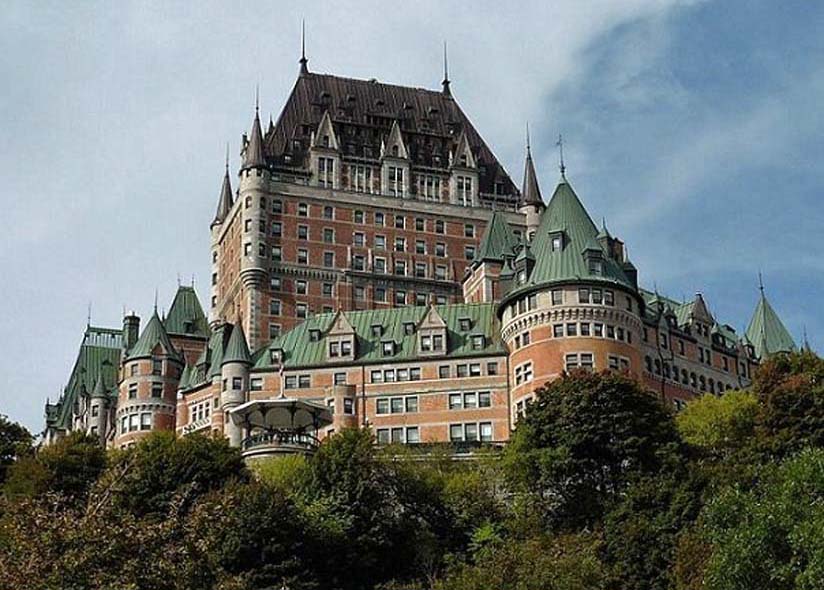

Quebec City Quebec - Listed as a National Historic Site of Canada, the Fairmont Chateau Frontenac is among the nation's most celebrated
historic landmarks.
This spectacular retreat is located in the heart of Old Quebec, which served as the seat of colonial French power in North America over the better part of two
centuries.
It was from this location that France presided over thousands of acres that stretched from the Great Lakes to the bayous of Louisiana.
Old Quebec then became the headquarters in Canada for the British when they wrestled control of the region away from France during the Seven Years'
War.
Fairmont Chateau Frontenac resides on the grounds of the former Chateau St. Louis, which functioned as the main administrative office for both the French and
British colonial governments in Quebec City until it burnt down in 1834.
American William Van Horne, President of the Canadian Pacific Railway, chose the site of the former Chateau St. Louis as the location for an extravagant
hotel.
The ambitious railroad magnate had hoped to spur travel along his company's new rail lines by developing a series of ornate lodgings that could appeal to
upscale travelers.
As such, he decided to construct what would become the Fairmont Chateau in downtown Quebec City for just that purpose.
Van Horne hired the renowned American architect Bruce Price to create the building's design, and construction began shortly thereafter in 1892.
Price had used a special architectural style known as "Chateauesque," which borrowed heavily from Revivalist and French Renaissance design
aesthetics.
As such, the new hotel resembled a grand historic manor native to France's Loire Valley.
When it finally debuted a year later, Van Horne chose to name the building as the Chateau Frontenac Hotel" in honor of the region's legendary colonial
governor, Louis de Buade de Frontenac.
Fairmont Chateau Frontenac has since emerged as one of the world's preeminent hotel destinations.
Countless international luminaries have stayed at this spectacular hotel over the years, including military aviator Charles Lindbergh, Princess Grace Kelly of
Monaco, French President Charles de Gaulle, and Queen Elizabeth II of the United Kingdom visited the Chateau Frontenac in the past.
The hotel's magnificent architecture and beautiful decor also inspired the famous film director, Alfred Hitchcock, to shoot portions of his classic thriller, I
Confess, on-site in 1953 starring Montgomery Clift and Anne Baxter.
But Chateau Frontenac has been the site of major historical events as well, such as the Quebec Conferences of World War II.
Held between 1943 and 1944, these meetings were chaired by U.S. President Franklin Delano Roosevelt, British Prime Minister Winston Churchill, and Canadian
Prime Minister William Lyon Mackenzie King.
Together, they discussed invasion plans for Western Europe, as well as the shape of the postwar world.
In 1993, the hotel saw another expansion, with the addition of the new wing that included a pool, fitness center, and outdoor terrace.
On 14 Jun 1993 Canada Post issued a stamp designed by Kosta Tsetsekas, based on illustrations by Heather Price.
The stamp features an image of the hotel building and is printed by Ashton-Potter Limited.
In 2001, the hotel was sold to Legacy REIT, which is partially owned by Fairmont, for $185 million.
The hotel was renamed the Fairmont Chateau Frontenac in November 2001, shortly after Canadian Pacific Hotels reformed itself as Fairmont Hotels and Resorts,
taking the name of an American company it acquired in 2001.
In 2011, the hotel was sold to Ivanhoe Cambridge.
Shortly after acquiring the hotel, Ivanhoe Cambridge announced an investment of $9 million for the restoration of the building's masonry work, and the
replacement of the building's copper roofs.
The company further announced another $66 million investment for general improvements and renovations throughout the hotel.
When the roof was being replaced, an image of the roof was printed on polypropylene safety netting and hung from scaffolding to hide the refurbishing project
from view.
The extensive renovation saw conference rooms expanded, restaurants remodeled, modernization of the lobby, and the gutting and rebuilding of three-fifths of
the hotel's rooms.
Stanley Turkel.
(because there was no image with original article)
(usually because it's been seen before)
provisions in Section 29 of the Canadian
Copyright Modernization Act.
